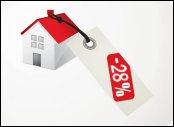
RealtyTrac released its Year End and Q4 U.S. Foreclosure Sales Report which disclosed that foreclosures accounted for nearly 26 percent of all residential sales nationwide last year. That was a decrease of 29 percent from the year before and 23 percent lower than 2008. The decrease was attributed to the “robo-signing” controversy that slowed foreclosure sales to a crawl at the start of the fourth quarter while lenders reviewed documentation policies. The report also reveals that the average price of a foreclosed property was 28 percent lower than the average price of a property that was not in foreclosure. Traditionally, foreclosures account for less than 10 percent of all home sales.
For the year, a total of 831,574 U.S. residential properties were either owned by the banks or were in some stage of foreclosure, either in default, scheduled for auction, or sold to third parties. That amount was down 31 percent from 2009 and nearly 14 percent from 2008.
For the fourth quarter, 149,303 foreclosure sales were recorded, down 22 percent from the previous quarter and down 45 percent from the fourth quarter in 2009 despite a 21 percent increase in foreclosure sales in December.
“Foreclosure sales in the fourth quarter faced the twin headwinds of the expired homebuyer tax credit — which began to stifle sales volume during the third quarter — and the foreclosure documentation controversy, which hit in the fourth quarter and temporarily froze sales of foreclosures from several major lenders,” said James J. Saccacio, chief executive officer of RealtyTrac. “Given those factors, it’s not surprising that in the fourth quarter foreclosure sales volume hit its lowest level since the first quarter of 2008.”
As one might expect due to the large amount of defaults in the last two years, Nevada, Arizona, and California grabbed the lion’s share of foreclosure sales. Nevada continued to have the highest percentage of foreclosure sales with 57 percent of all residential sales being foreclosures. That was still down from a peak of 67 percent of all sales in 2009.
Arizona followed with foreclosure sales accounting for 49 percent of all sales in 2010, which was still down from 54 percent in 2009. California was third with foreclosure sales accounting for 44 percent of all sales in 2010, down from a peak of 57 percent in 2009.
Rounding out the top ten were Florida (36 percent), Michigan (33 percent), Georgia (29 percent), Idaho (28 percent), Oregon (28 percent), Illinois (26 percent), and Virginia (25 percent).
Ten states also posted foreclosure discounts of over 35 percent in 2010. The highest was Ohio where foreclosures sold for an average of nearly 43 percent less than non-foreclosed properties. Kentucky was next with an average discount of more than 40 percent, with the other eight states being Tennessee, California, Pennsylvania, Illinois, New Jersey, Michigan, Georgia and Wisconsin.
“Still, foreclosures continue to represent a substantial percentage of all U.S. residential sales and continue to sell at an average sales price that is significantly below the average sales price of properties not in foreclosure — the result of a bloated supply of foreclosures and weak demand from homebuyers,” Saccacio continued. “The catch-22 for 2011 is that while accelerating foreclosure sales will help clear the oversupply of distressed properties and return balance to the market in the long run, in the short term a high percentage of foreclosure sales will continue to weigh down home prices.”
Tags: RealtyTrac, foreclosure sales report, residential properties, foreclosures, foreclosure discounts, documentation controversy
No comments:
Post a Comment